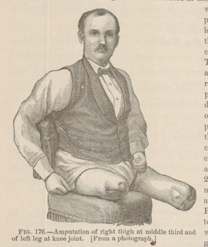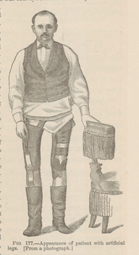Title: Lapham, C. N.
Source text: The Medical and Surgical History of the War of the Rebellion. (1861-65.), Part 3, Volume 2 (Washington, DC: Government Printing Office, 1883), 224.
Civil War Washington ID: med.d2e10533
TEI/XML: med.d2e10533.xml
CASE 436.—Corporal C. N. Lapham, Co. K, 1st Vermont Cavalry, aged 23 years, was wounded during the engagement near Boonsboro', July 8, 1863, by a cannon ball, which carried away both legs. He was conveyed to the field hospital at Boonsboro' where both limbs were amputated two days after the receipt of the injury. Four months after the operation the patient was deemed well enough to be allowed to go to his home, where he remained until the following year. On May 31, 1864, he was furnished with artificial limbs by Dr. E. D. Hudson, of New York City, who contributed the photographs represented in the annexed cuts (FIGS. 176, 177) and the following description of the operation: "The right thigh was amputated at the middle third, by the antero-posterior flap method, on account of great comminution of the leg involving the knee joint; the stump is healed and in a favorable condition. The left leg was disarticulated at the knee joint. This operation was also performed by antero-posterior flaps, and the stump is healed and in good condition, though the supporting cicatrix at the base is not good. The condyles of the femur, as a base, form the most useful, reliable, and comfortable support, and constitute his chief dependence, and the benefits of disarticulation, when compared with amputations of the thigh, are shown to be incalculable." The patient was discharged from Baxter Hospital, at Burlington, Vermont, Aug. 25, 1864, and pensioned. Five months later, when a student at the Collegiate Institute in Poughkeepsie, N. Y., he wrote to Dr. Hudson that "he could walk with ease on level ground, get up and down stairs readily, and was getting along much better than he anticipated in so short a time." Some time afterwards he obtained an appointment as clerk in the U. S. Treasury Department at Washington, in which occupation he is still employed. His pension was paid September 4, 1879. In his application for commutation he reported that Surgeon L. P. Woods, 5th New York Cavalry, was the operator who amputated his limbs.

